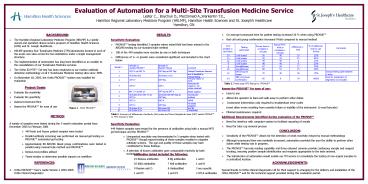Evaluation of automation for a multisite TMS - PowerPoint PPT Presentation
1 / 1
Title:
Evaluation of automation for a multisite TMS
Description:
... Medicine Program (HRLMP), Hamilton Health Sciences and St. Joseph's Healthcare ... service program of Hamilton Health Sciences (HHS) and St. Joseph Healthcare. ... – PowerPoint PPT presentation
Number of Views:111
Avg rating:3.0/5.0
Title: Evaluation of automation for a multisite TMS
1
Evaluation of Automation for a Multi-Site
Transfusion Medicine Service Lester C. , Boychuk
D., MacDonald A.,Warkentin T.E., Hamilton
Regional Laboratory Medicine Program (HRLMP),
Hamilton Health Sciences and St. Josephs
Healthcare Hamilton, ON
- BACKGROUND
- The Hamilton Regional Laboratory Medicine Program
(HRLMP) is a jointly owned and operated clinical
service program of Hamilton Health Sciences (HHS)
and St. Joseph Healthcare. - HRLMP operates four Transfusion Medicine (TM)
laboratories located in each of the acute care
sites across the two institutions under a single
management structure. - The implementation of automation has long been
identified as an enabler to the consolidation of
our Transfusion Medicine services. - The Ortho ID-MTS Gel test has been employed as
our routine antibody detection methodology at all
4 Transfusion Medicine testing sites since 1999. - On November 18, 2005, the Ortho PROVUE system
was installed for evaluation
- On average turnaround time for patient testing
increased 36 when using PROVUE - Red cell unit group confirmation increased 9-fold
compared to manual method
- RESULTS
- Sensitivity Evaluation
- PROVUE testing identified 3 samples where mixed
field had been missed in the ABO/Rh testing by
our standard tube method - 100 of the 449 samples were reactive by one or
both techniques - Differences of 1 or greater were considered
significant and included in the chart below
Table 2. Timed study MTS Manual vs. PROVUE
- Project Goals
- Evaluate the sensitivity
- Evaluate the specificity
- Assess turnaround time
- Assess the PROVUE for ease of use
- Assess the PROVUE for ease of use
- Easy to use
- Allows the operator to load and walk away to
perform other duties - Instrument intervention only required to
troubleshoot error codes - (most often errors resulting from cassette
failure or inability of the instrument to read
barcode) - Minimal maintenance required
- Additional Requirements identified during
evaluation of the PROVUE - Need for interface with computer system to
facilitate reporting of results - Need for tube cap removal process
Figure 1. Ortho PROVUE
Table 1. Summary of differences of antibody (Ab)
screen and Direct Antiglobulin tests (DAT)
results PROVUE vs. MTS manual or tube
- METHOD
- A variety of samples were tested during the
3-month evaluation period from December 2005 to
February 2006 - 449 fresh and frozen patient samples were tested
- Parallel antibody screening was performed via
manual gel testing vs. PROVUE automated gel
testing - Approximately 80 ABO/Rh blood group confirmations
were tested in parallel using manual tube method
and PROVUE - Various test profiles utilized
- Timed studies to determine possible impacts on
workflow
- Specificity Evaluation
- 449 Patient samples were tested for the presence
of antibodies using both a manual MTS gel
technique and the PROVUE - Unexpected reactivity was demonstrated in 5
samples when tested with PROVUE though repeat
testing of these samples resulted in negative
antibody screens. The age and quality of these
samples may have contributed to these findings. - A selection of known antibodies gave comparable
reactivity by both techniques
- CONCLUSION
- Sensitivity of the PROVUE allows for the
detection of weak reactivity missed by manual
methodology - Although turnaround time was markedly increased
automation provided the user the ability to
perform other duties while testing was in
progress. - The PROVUE barcode reading capability and three
onboard cameras provide continuous sample and
reagent tracking, ensuring positive sample
identification and reagents appropriate to the
tests ordered. - The introduction of automation would enable our
TM service to consolidate the testing of
non-urgent samples to a centralized location.
- Antibodies tested included the following
- 19 Rhesus antibodies 8 Bg antibodies 1 anti I
- 10 Kidd antibodies 7 Kell antibodies 1 anti H
- 9 Passive anti D 8 Unidentified 3 non
specific - 1 anti M 1 anti P1 2 HTLA antibodies
- REFERENCES
- Ortho PROVUE Users Guide Version 2 2004-2005
Ortho Clinical Diagnostics
ACKNOWLEDGEMENTS Special thanks to
Ortho-Clinical Diagnostics Ltd for their support
in arranging for the delivery and installation of
the Ortho PROVUE and for the technical support
provided during this evaluation period.































